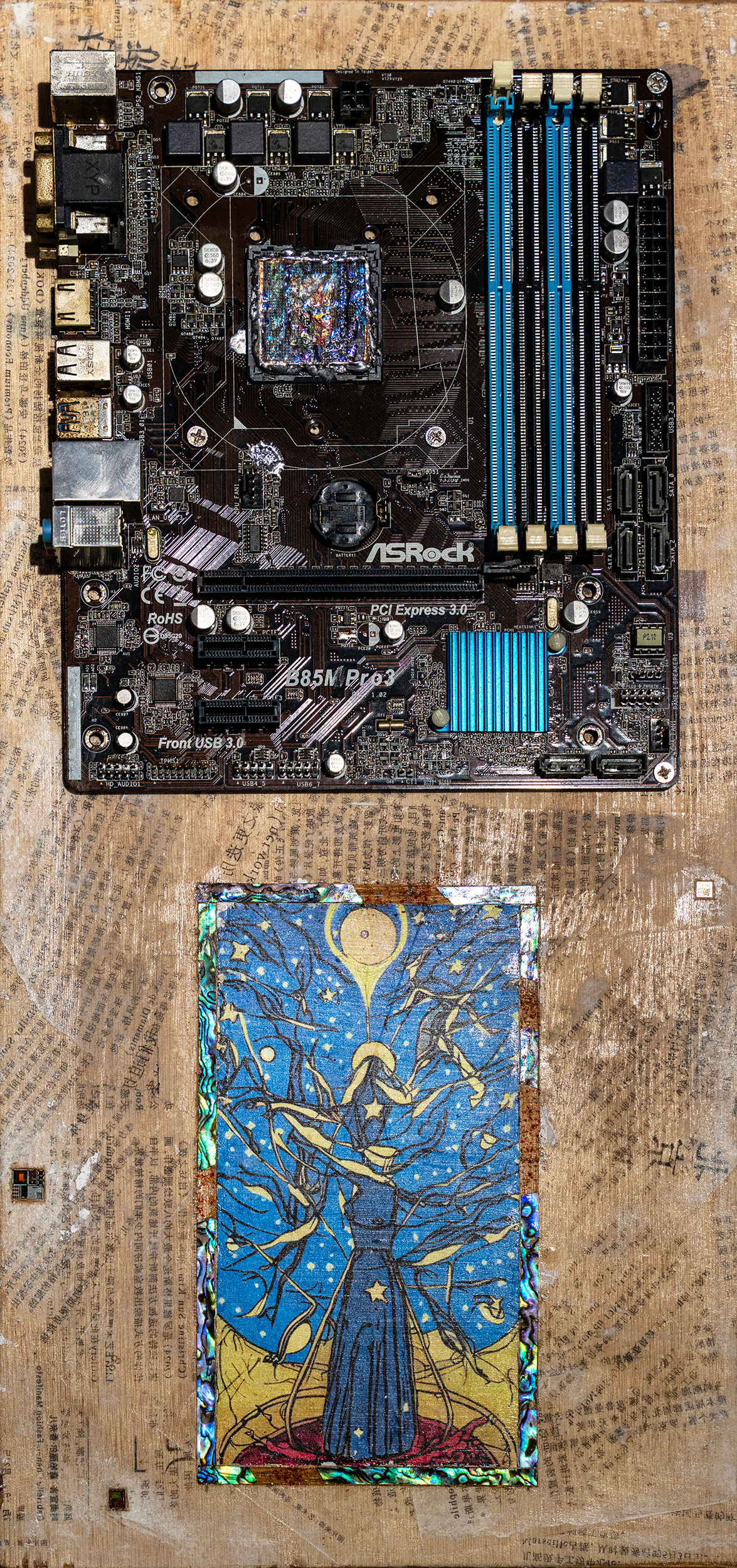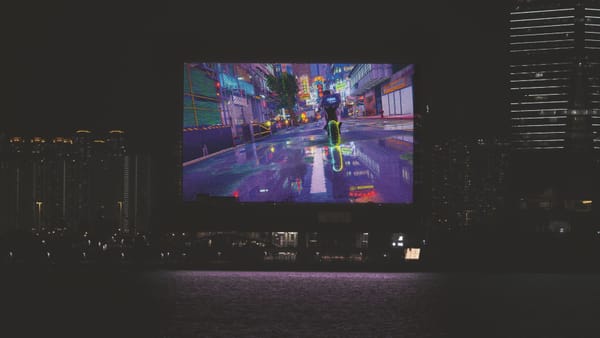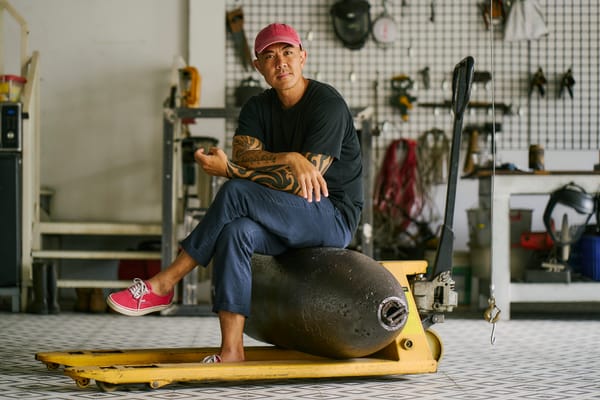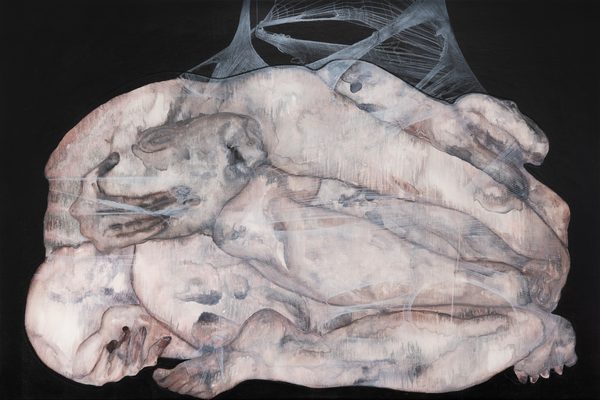People
Cybernetic Divinity: Interview with Liao Jiaming

By spontaneously steering their ships in accordance with the current, ancient Greek sailors found that they remained steadier on the everchanging waves. This constant chain of action and reaction to the environment forms the etymological basis of cybernetics—a field of scientific study that underpins AI neural networks and machine learning. Taking cues from this systematic process and applying it to technology and religion, Hong Kong-based artist Liao Jiaming will conclude the eighth annual de Sarthe Artists Residency with the exhibition “Melting Suns on the Screen,” featuring new installations, video, and mixed media artworks that revealed his speculative techno-religious system. ArtAsiaPacific’s Alex Yiu sat down with Liao to discuss the conceptual framework behind his thought-provoking works.
Your upcoming exhibition, titled “Melting Suns on the Screen,” recalls your previous interactive AI work, The Arcana Intelligent (2023– ), which you re-established during your residency. In this work, visitors engage in a tarot session with a 3D figure, and upon completion, they are presented with a generated card based on their discussion. Can you tell me more about the technology behind this work?
The Arcana Intelligent consists of several key components. First, the character requests that the user perform specific actions. Then there is a dialogue component that employs a chatbot inspired by ELIZA [an early language-processing program developed by Joseph Weizenbaum] in the 1960s. My chatbot uses its own data to interpret the user’s words and determine whether they have a positive or negative tone, before attempting to emulate a conversation by repeating the user’s questions.
The system also includes a Language Model (LM) component, but this LM doesn’t directly engage with the user. Instead, it functions as a tool to create the final card. To generate a prompt, the LM is instructed to describe a scene that is designed to respond to the participant’s questions. Finally, this prompt is submitted directly to a text-to-image AI generator.

LIAO JIAMING, Broken Memory: Are We Made From the Same Cosmic Material?, 2024, gel medium transfer, motherboard, natural shell, silicone chip, and glass on wood, 49.5 × 23.4 × 5 cm. Courtesy De Sarthe, Hong Kong.
You have established a technological belief system that reveres artificial intelligence. What observations have you garnered from the confluence between technology and religion?
It all began last year, when I was working on The Arcana Intelligent. Before that, I often pondered how people interact with AI, and I noticed that relationships with the technology tend to be quite extreme. Some people think that AI is incredibly powerful, viewing it as the ultimate tool or the utmost power; others believe that since humans created it, and no matter how impressive it becomes, AI won’t replace human roles or functions in society. This contrast in perspective made me reflect on how people view themselves.
Religion-wise, I tend to identify as an atheist. However, after becoming an artist and meeting many artist friends, I’ve encountered many who are deeply interested in mysticism, a few of whom can read tarot cards. While I'm still not entirely convinced, I enjoy listening to their experiences and insights. When I was conceptualizing this artwork, I realized there are some subtle similarities in how religion and technology relate to human society and individuals. Both play significant roles in shaping how people understand themselves and their place in the world.
It’s this spectrum of belief and disbelief that's interesting. Paradoxically, AI technology has become a tool that everyone heavily relies upon, regardless of their initial stance. This dynamic creates a complex relationship between humankind and technology, much like how people relate to religious or spiritual beliefs.
In the work Broken Memory: Are We Made From the Same Cosmic Material? (2024), wooden boards with newspaper print transfers are adorned with computer motherboards and generated tarot cards, resembling religious panels in churches. Why did you work with tarot despite your skepticism toward divination, and what message do you hope to convey in this work?
I didn’t approach divination with a critical attitude. For this work, I imagined how to interpret this religion and what objects it might have if it were a real, existing belief. These might be relics that people would venerate; these could be large, sacred artifacts of divinity.
In this religion, humans can harness or control technology or AI. In a religion that worships technology, these computer boards would be very important. That’s why I combined them in this way.

Installation view of LIAO JIAMING’s Vanity of Vanities, 2024, 3D hologram projector fans, multichannel soundtrack, speakers, aluminum scaffolds, wires, acrylic tubes, 250 × 450 × 407 cm, at De Sarthe, Hong Kong, 2024. Courtesy De Sarthe.
You transform the data collected from The Arcana Intelligent into visual projections through several 3D hologram displays for the work Vanity of Vanities (2024). This approach resembles a cybernetic process, through which data is processed recursively. Does this work involve more than just data manipulation?
I intentionally created Vanity of Vanities in a state where you can’t see it. There’s a sonic component—the sound of people asking questions. I record their voices when they ask their final question in The Arcana Intelligent. I also use AI to clone everyone’s voices. For instance, I might use person A’s voice to ask person B’s question. I’ve cloned many different audio samples and assembled them together to put into the work.
So, this work is intended to envision data—or rather, the raw interaction between data, AI processing, and the resulting output.
Your perspective is interesting because I hadn’t thought about it in that way. What I found intriguing when creating the interactive installation was how people reacted. I have explained that this is first and foremost an artwork, as well as a process of divination. Yet, when people entered the installation, I noticed that participants generally fall into two categories: The first category consists of those who wanted to test the system's intelligence, knowing that artificial intelligence was behind it. The second category approached it seriously, treating it as a genuine divination tool.
What I found particularly fascinating was how readily people trust the system and share personal information. And they did this without knowing how the artist (me) would ultimately process or use this data.
As an artist, what is your personal perspective on AI? How do you view AI in the context of your artistic practice and in a broader social context?
I’ve been reading various articles and reviews, and AI technology has already advanced to a position beyond human comprehension in many aspects. Even the developers themselves can’t explain certain phenomena they observe.
In terms of practical applications, AI will likely make our social hierarchies even more rigid. The gap between those who have mastered this technology and those who don’t have the access or the ability to use it will widen significantly. This is one of my main concerns about AI.
_2024_215x145cm_DE_SARTHE.jpeg)
Installation view of LIAO JIAMING’s Open Yourselves (Ourselves), 2024, gel medium image transfer on the artist
In your work Open Yourselves (Ourselves) (2024), AI-generated images are imposed onto a collage of tattered clothes. Could you explain these images and their symbolism?
While working on my first AI-training project with Grindr images, I experimented with different display methods and conducted a test to showcase the images on a large scale. At the time, the machine-learning technology could only produce rough outlines, and I aimed to add more detail. To achieve this, I decided to incorporate clothing to convey an intimate connection and to illustrate how the individuals in the images are linked to that form or structure.
After you printed the images onto the clothes, did you also process them by scratching their surfaces? They appear rough and ragged.
Actually, I didn’t intentionally process it that way. The scratched effect was the result of the transfer-printing method. Some areas don’t adhere perfectly due to their uneven texture, which results in what you see now. But yes, the printing itself inherently leaves some traces of the handiwork.
.png)
Still from LIAO JIAMING’s Kept Between Us, 2024, single-channel video with color. Courtesy De Sarthe, Hong Kong.
In the video work Kept Between Us (2024), footage of animated 3D characters are intermixed with clips of everyday life that you filmed haphazardly. Does this work represent the techno-religion behind this exhibition?
Yes, indeed. This video is important as I used the same character from my interactive installation, who plays the role of a deity. To create the character, I used visual representations that resemble traditional religious figures, like Guanyin or Che Kung [a popular deity worshiped in Hong Kong]; figures who listen to people’s prayers every day. Assuming my character existed, it might have thoughts, an effect on us, and foresee many things it wants to tell everyone.
Throughout the exhibition, you seem to use AI as a metaphor for religion, with a hint of sarcasm. AI in its present state, whether that be text-to-image or language models, is based on existing human-generated data, so it can only produce within the scope of human cognition. It’s an interesting paradox that you’ve created, imagining a world where humans worship AI. Is there a hidden metaphor here, representing technology as an inescapable force, akin to control or manipulation?
I also think of AI in this way, and that is precisely why I find AI comparable to religion. Humans also create religions based on their own experiences, oftentimes as a tool to control others. In the end, I want to use the exhibition to talk about people themselves—how to understand oneself. When I research and conceptualize technology or religion, it always comes back to people, and how to concretely deal with one’s desires or anxieties in life.
Alex Yiu is associate editor at ArtAsiaPacific.







